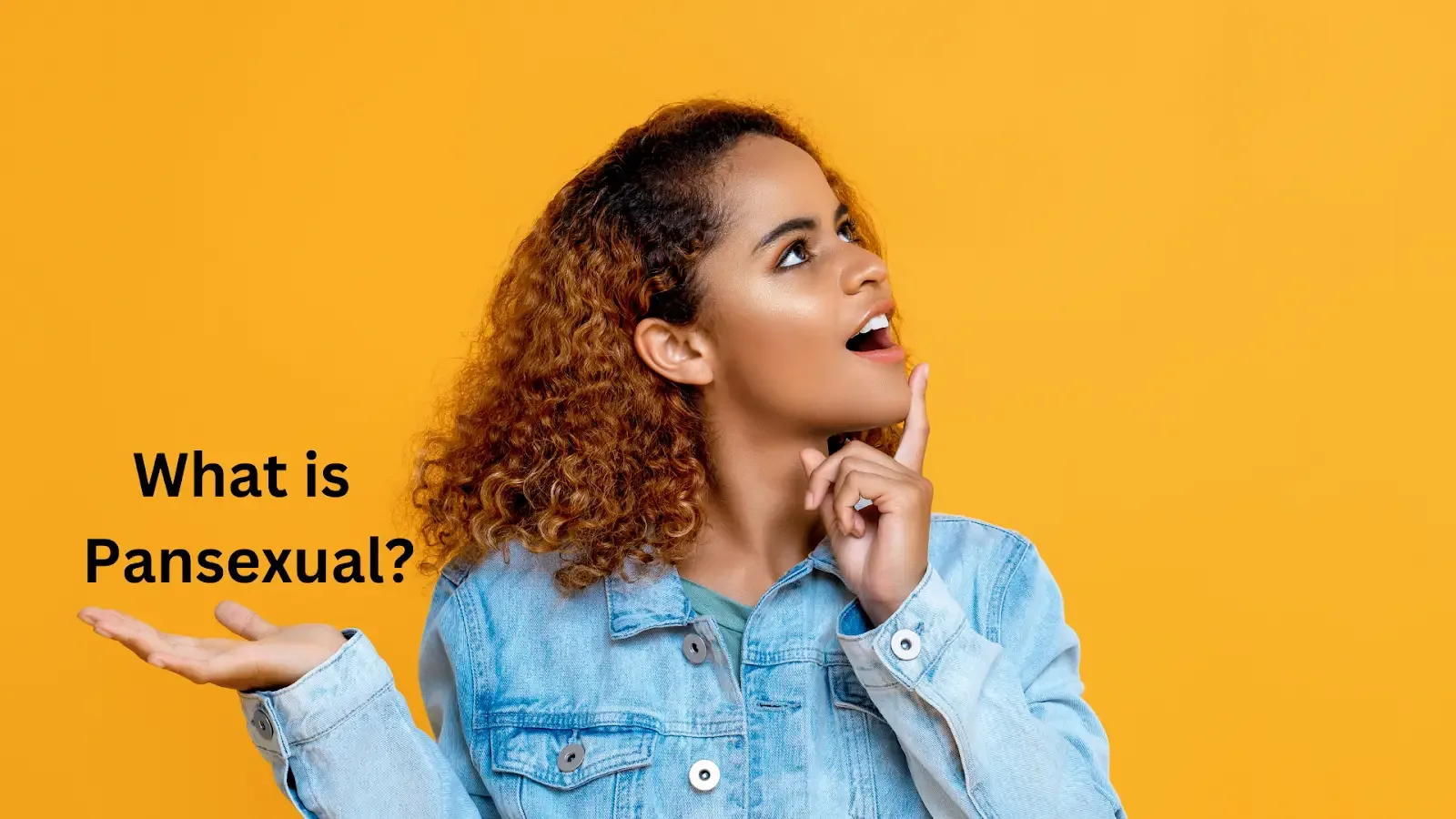
Today, we’re diving into what is pansexual and why it matters.
Ever wondered, “What is pansexual?”
First off, let’s clear up a biggie: pansexuality doesn’t mean “liking everyone and everything.”
I mean, sure, I love pizza and puppies, but that’s a whole different vibe.
What is Pansexual? Here’s the Not-So-Boring Definition
So, what is pansexual?
Pansexuality is simply being attracted to people regardless of their gender.
In other words, pansexuals are drawn to the person, not their gender label.
Think of it this way: they’re into “hearts, not parts.”
But let’s go deeper than that “heart-parts” stuff because pansexuality is more than a cute rhyme. It’s about connection and attraction beyond gender boundaries.
Pansexuality isn’t just bisexuality with a twist.
While bisexuals may feel attracted to multiple genders, pansexuals often see gender as kind of irrelevant.
It’s like if they’re drawn to someone, that person’s gender doesn’t even come into the equation. Neat, huh?
How Does Pansexuality Work? (No, It’s Not a Superpower)
So, how does pansexuality actually work?
Well, it’s not like having a superpower where you’re instantly attracted to everyone you meet!
Pansexual attraction is a bit more… let’s say, mysterious.
It’s about feeling a connection to someone based on who they are rather than what gender they fall into.
Imagine walking into a room and feeling drawn to someone.
A pansexual person might notice their laugh, their kindness, or the way they talk about their passions.
These qualities spark attraction, and gender doesn’t factor into the equation.
For pansexuals, the whole person, their energy, personality, and uniqueness, takes center stage.
Gender is more like background noise: it’s there, but it’s not the focus.
And here’s the thing: pansexual attraction doesn’t mean “attracted to everyone.”
Pansexual people have types, preferences, turn-ons, and turn-offs, just like anyone else.
They may be into certain personalities, quirks, or even the way someone thinks.
Some pansexuals are drawn to confident people, while others might swoon over the shy, bookish types.
But it’s the individual traits that matter most, not their gender.
To be clear, pansexuality isn’t a free-for-all attraction!
Think of it like a key and a lock.
Not everyone has the “key” to a pansexual’s attraction.
But when someone does?
Gender just happens to be irrelevant.
It’s about what makes that person that person.
The idea of gender is there, but it’s like white noise in the background.
One way to look at it is that pansexual attraction is a bit like reading a book.
It’s the story, the essence, the twists that keep you interested, not the cover or the genre label.
They’re connecting to the person and the connection they feel rather than checking off a list that includes gender.
For some pansexuals, this means they feel free to love whoever they feel close to, whether that’s a man, woman, non-binary person, or anyone else along the gender spectrum.
They don’t ignore genders.
It’s that gender just doesn’t play a part in their attraction at all.
It’s like watching a movie in black and white, the story is what’s gripping, and the color details (in this case, gender) aren’t as important.
Comparing Pansexuality with Other Cool, Lesser-Known Orientations
Pansexuality is just one part of the big, colorful puzzle of human attraction, and it’s far from alone.
Let’s take a peek at some other lesser-known orientations that are equally fascinating.
These orientations show us that attraction is multi-dimensional and that people connect in all sorts of unique ways.
Cupiosexual: Imagine someone who genuinely wants a romantic relationship but doesn’t feel sexual attraction.
Cupiosexual people might crave emotional closeness and commitment but feel pretty indifferent about the sexual side of things.
It’s like saying, “I want the candlelit dinners and cute date nights, just hold the bedroom scenes.”
Aegosexual: These folks might find sexual topics intriguing and may even enjoy imagining romance and intimacy but don’t feel a desire to experience it themselves.
They’re kind of like fans watching from the stands, cheering on love and romance without needing to jump into the game themselves.
Lithosexual: Now here’s a twist!
Lithosexual people can feel sexual attraction, but here’s the catch: they don’t necessarily want it reciprocated.
They might get butterflies over someone but would rather keep it as a one-way street.
It’s like having a crush on a celebrity or fictional character and being happy with it staying that way.
Sapiosexual: For sapiosexuals, it’s all about brains and intellect. Intelligence is the main attraction factor here, and it can make someone swoon over things like deep conversations, clever jokes, or intellectual debates.
They’re drawn to the mind before anything else, and if someone’s got the smarts, they’ve got a shot.
Panromantic: Similar to pansexuals, panromantics feel romantic attraction to people regardless of gender.
However, for panromantics, this attraction doesn’t always include a sexual component.
They might feel head-over-heels, write poems, and plan dates with anyone on the gender spectrum, but it’s all about the heart without the “heat.”
Heteroflexible: Here, attraction is mostly toward the opposite gender, but there’s some flexibility.
Heteroflexible folks are open to same-gender attraction on occasion.
Think of it as mostly having a “type” but with a few surprise exceptions.
It’s like saying, “I usually like vanilla, but I’m not opposed to a little twist now and then.”
Sapiophile: This orientation is similar to sapiosexual, but with a slightly different flavor.
Sapiophiles are attracted to intelligence in a way that goes beyond romance and veers into soul connection territory.
They’re often looking for a true mental match and might feel an intellectual kinship that’s as deep as it is rare.
Polyamory: Polyamory isn’t strictly about sexual orientation, but it’s a relationship style that can fit with any of the above orientations.
Polyamorous people may pursue multiple romantic or sexual relationships at the same time, with everyone’s consent.
It’s a reminder that love doesn’t have to be limited to one person or one style.
Polyamory embraces the idea that multiple connections can coexist happily.
Each of these orientations showcases how rich and diverse attraction truly is.
Pansexuality is one part of this spectrum, where the attraction is more about the individual and less about the gender.
Meanwhile, orientations like cupiosexual, aegosexual, and lithosexual reflect how people experience attraction on an emotional, intellectual, or even selective basis.
By looking at these different identities side by side, we get a sense of how each orientation is like a different hue in the rainbow of human attraction.
It’s all about discovering what makes you feel seen, understood, and connected, no matter what “label” fits you best!

Myths About Pansexuality (Time to Set the Record Straight)
Pansexuality comes with its fair share of myths, and some are downright wild!
Let’s bust a few of the biggest misconceptions and set the record straight.
Myth #1: Pansexuals like everyone.
A common misconception is that pansexuals are attracted to literally everyone they meet.
Nope!
Being pansexual doesn’t mean you’re constantly catching feelings or crushing on every human who walks by.
Pansexuals, like anyone else, have tastes and preferences.
They don’t “like everyone”.
they’re simply open to attraction regardless of someone’s gender.
It’s more about the possibility of attraction to any gender, not an automatic attraction to every single person.
Myth #2: Pansexuals are “just indecisive.”
Pansexuality isn’t about not being able to choose or about feeling confused.
It’s not some “can’t make up their mind” situation.
Pansexuals are clear about what they’re attracted to: people, regardless of gender.
They know what they want, and indecisiveness has nothing to do with it.
Attraction just goes beyond gender, not in circles of indecision!
Myth #3: Pansexuality is a trend.
Some people say pansexuality is just a new trend or a “buzzword” that young people have come up with.
But pansexuality isn’t a fad of the 2020s. It’s been around for as long as people have, though the word may be newer to some.
Historical evidence shows that people have experienced this type of attraction across cultures and centuries.
Labels like “pansexual” simply help people express who they are in a world that’s learning to appreciate more diverse identities.
Myth #4: Pansexuality and bisexuality are the same.
While pansexuality and bisexuality can overlap, they aren’t identical.
Bisexuality often refers to attraction to two or more genders, while pansexuality describes an attraction that’s not based on gender at all.
Some pansexuals see themselves as attracted to “all genders,” but many describe their attraction as “gender-blind.”
The difference is subtle but meaningful.
For pansexuals, gender doesn’t play a central role in attraction; for some bisexuals, gender may still influence who they’re drawn to.
Myth #5: Pansexuality means you’re “open to everything” in relationships.
Being pansexual doesn’t mean that you’re automatically open to every kind of romantic or sexual experience.
Pansexual people still have boundaries, comfort zones, and personal preferences just like anyone else.
They aren’t inherently “experimental” or “kinky” just because their attraction isn’t gender-specific.
Pansexuality is about who they’re attracted to, not about saying yes to everything in a relationship.
Myth #6: Pansexuality invalidates other identities.
There’s a misconception that pansexuality somehow erases or dismisses other orientations, especially bisexuality.
But pansexuality isn’t about saying, “This label is better than yours.”
It’s simply another way to describe attraction.
There’s room for both pansexual and bisexual identities (and others!) within the LGBTQ+ spectrum.
Pansexuality simply adds to the diverse ways people experience attraction, it doesn’t take anything away from anyone else.
Myth #7: Pansexuality is just a phase.
Like many LGBTQ+ identities, pansexuality is often dismissed as a “phase.”
People sometimes assume that pansexuals are just experimenting or trying something new.
But for most pansexuals, this identity is a stable, lasting part of who they are.
They’re not likely to “grow out of it” or “settle down” into a more “traditional” label.
Pansexuality is a valid, enduring orientation that’s as real as any other.
Pansexuality, like any orientation, is complex and personal.
Busting these myths can help foster a better understanding of what pansexuality really means and make the world a more inclusive, welcoming place.
Pansexuality isn’t about being indecisive, trendy, or overly flexible.
It’s about attraction that looks beyond gender boundaries and embraces people for who they are.
Conclusion
Understanding identities like pansexuality opens doors to better communication, empathy, and connection with our partners.
Whether you’re exploring new perspectives on attraction or simply deepening your understanding, it’s all about being open, honest, and supportive in relationships.
And speaking of building stronger relationships, have you tried the Better Topics Card Game for Couples?
The Better Topics Card Game is designed to bring couples closer by sparking meaningful conversations in a playful way.
With repeatable questions, you can play it over and over, each time discovering something new about each other.
It’s the perfect way to improve communication, strengthen your bond, and keep things light-hearted and fun, no matter how long you’ve been together.
So why not give it a try?
Grab a deck, sit down with your partner, and watch as your conversations reach new depths.
The Better Topics Card Game isn’t just a game.
It’s a tool for love, laughter, and lasting connection.










